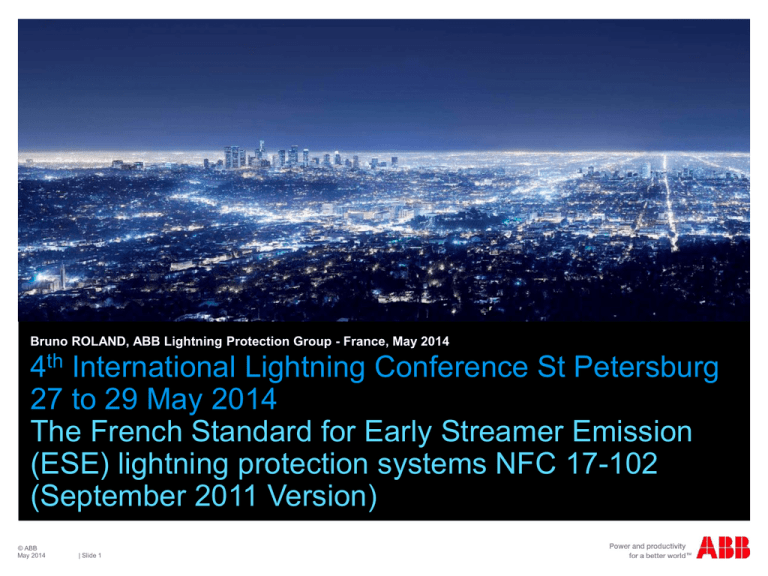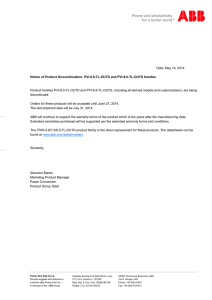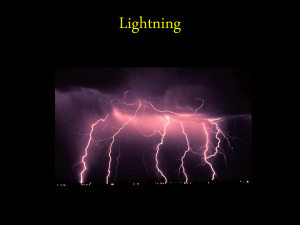ABB Template
advertisement

Bruno ROLAND, ABB Lightning Protection Group - France, May 2014 4th International Lightning Conference St Petersburg 27 to 29 May 2014 The French Standard for Early Streamer Emission (ESE) lightning protection systems NFC 17-102 (September 2011 Version) © ABB May 2014 | Slide 1 The French Standard for Early Streamer Emission (ESE) lightning protection systems NFC 17-102 (September 2011 Version) Harmonization with EN 62305 Series EN 62305 series standard is recognized as a reference in the field of lightning protection of conventional type. This standard explains how to select, install and verify conventional systems of protection against lightning. Since there is no particular reason for the rules systems with passive rods differ from those governing systems with ESE Lightning Protection systems, NF C 17102, 2011 version has been created to harmonize the two sets of constraints. Including stress tests of the previous editions of the NF C 17102 had to be more severe than passive to ensure proper functioning of ESE Active Lightning Rod. Series EN 62305 does not cover ESE Lightning Rod technology devices, revision of the NF C 17-102 appeared essential to provide the design requirements of an ESE lightning rod and those of a lightning protection system that implementing them. © ABB May, 2014 | Slide 2 The French Standard for Early Streamer Emission (ESE) lightning protection systems NFC 17-102 (September 2011 Version) Harmonization with EN 62305 Series Continued An international working group was formed to create an entirely new standard. It was important to have international commentary to use this standard as a basis for all countries already using ESE Lightning Rod Systems or those who wish to use it. These countries have taken or will take standard NF C 17102 (2011 September version) as a reference to create their own national standards. So this new NF C 17102 Edition (Version 2011) is a complete overhaul of the standard following the publication of the series of European standards EN 62305 and EN 62305-3 particularly giving the requirements for protection of structures against lightning. © ABB May, 2014 | Slide 3 The French Standard for Early Streamer Emission (ESE) lightning protection systems NFC 17-102 (September 2011 Version) Harmonization with EN 50164 Series The standard EN 50164 is the standard reference for lightning protection components for which manufacturers and suppliers must test their lightning protection components to verify the design and quality. As with the standard EN 62305, there is no particular reason that the rules of passive lightning protection components differ from those governing by ESE lightning protection systems, revision of the NF C 17-102 was created to harmonize the two sets of constraints. Furthermore, as the series EN 50164 does not address ESE lightning protection components technology, revision of the NF C 17-102 appeared essential to provide the design requirements and quality for ESE lightning protection components. Harmonization with EN 62 305-2 © ABB May, 2014 The method of lightning risk analysis of the 62305-2 standard Ed.1 was fully integrated in Appendix A of the NFC 17-102 standard without any modification. It will be necessary to update the 17-102 standard to reflect the Edition 2 of the European standard. | Slide 4 The French Standard for Early Streamer Emission (ESE) lightning protection systems NFC 17-102 (September 2011 Version) Highlight Annex C (Requirements and test procedures) The procedure described in this annex is detailed under the following chapters: © ABB May, 2014 C.1 Operation conditions C.1.1 Normal conditions The normal operating conditions are as follows: - operating temperature -20°C to 60°C; - wind speed lower than 122 km/h. C.1.2 Abnormal conditions The abnormal operation conditions are as follows: - operating temperature lower than -20°C or higher than 60°C; - wind speed higher than 122 km/h; - snow and ice; - site with highly polluted atmosphere. | Slide 5 The French Standard for Early Streamer Emission (ESE) lightning protection systems NFC 17-102 (September 2011 Version) Highlight Annex C (Requirements and test procedures) C.2 Requirements © ABB May, 2014 C.2.1 General requirements | Slide 6 C.2.1.1 Identification and documentation The ESEAT is identified by the following information indicated on the product (marking): - name, logo or trade mark of the manufacturer; - product reference; - early streamer emission efficiency : T (in μs); - serial number. C.2.1.2 Marking The information shall me marked legibly and indelibly. It shall include at least the name, logo or trade mark of the manufacturer, the reference of the product and the serial number. Checked by the tests in § C.3.1.2 (Marking Test). The French Standard for Early Streamer Emission (ESE) lightning protection systems NFC 17-102 (September 2011 Version) Highlight Annex C (Requirements and test procedures) C.2.2 Requirements for early streamer emission. The early streamer emission of the ESEAT (ΔT) shall be determined according to the procedures of clause C.3.5 (Early streamer emission tests). It shall range between 10 μs and 60 μs. If the result of ΔT is lower than 10 μs, then the air terminal will not be considered as an ESEAT. If the result of ΔT is higher than 60 μs, then all the calculations will be made considering ΔT = 60 μs. C.2.3 Electrical requirements The ESEAT shall be resistant to a lighting impulse of 100 kA (10/350 wave). This is verified by the tests defined in C.3.5 (Early streamer emission tests). C.2.4 Mechanical requirements The parts of the ESEAT through which the lightning current transits shall have a section compliant NF EN 50164-2 (possible spark gaps used in the design of the ESEAT are tested during the current withstanding tests and do not require mechanical requirements). © ABB May, 2014 | Slide 7 The French Standard for Early Streamer Emission (ESE) lightning protection systems NFC 17-102 (September 2011 Version) Highlight Annex C (Requirements and test procedures) C.2.4 Mechanical requirements (continuation) The parts of the ESEAT that shall capture the lightning shall have dimensional characteristics compliant with the table below. Table C.1 – Material, setup and minimum area of the striking point part's body NOTE 1: coating shall be smooth and continuous and shall not have any flux tarnishing. Minimum thickness shall be 50 μm. NOTE 2: Chromium 16 %, nickel 8 %, carbon 0.07 %. C.2.5 Environmental requirements © ABB May, 2014 C.2.5.1 Climate conditions The ESEAT shall resist environmental constraints such as salt spray and sulphide atmospheres characteristic of seaside pollution and industrial pollution. This is checked by carrying out tests described in C.3. | Slide 8 The French Standard for Early Streamer Emission (ESE) lightning protection systems NFC 17-102 (September 2011 Version) Highlight Annex C (Requirements and test procedures) © ABB May, 2014 C.2.6 Electromagnetic compatibility C.2.6.1 Electromagnetic immunity The ESEATs without an electronic system or for which all components are passive are not sensitive to the electromagnetic waves of industrial environments. Thus, no immunity tests are required. The other ESEATs shall be subjected to testing. These ESEATs shall be compliant with the NF EN 61000-6-2 immunity for industrial environments standard for applicable tests. C.2.6.2 Electromagnetic emission The ESEATs without an electronic system or for which all components are passive do not generate any signals outside of stormy conditions. Thus, no emission tests are required. ESEATs with electronic circuits shall be compliant with the NF EN 61000-63 emission standard for residential environments. For ESEATs that meet these conditions but include radio modules, all requirements described in the RTTE 1999/5/CE directive shall be met. | Slide 9 The French Standard for Early Streamer Emission (ESE) lightning protection systems NFC 17-102 (September 2011 Version) Highlight Annex C (Requirements and test procedures) © ABB May, 2014 C.3 Type test The tests shall be carried out on a sample according to the hereafter flowchart. | Slide 10 The French Standard for Early Streamer Emission (ESE) lightning protection systems NFC 17-102 (September 2011 Version) Highlight Annex C (Requirements and test procedures) © ABB May, 2014 C.3 Type test (continuation) | Slide 11 The French Standard for Early Streamer Emission (ESE) lightning protection systems NFC 17-102 (September 2011 Version) Highlight Annex C (Requirements and test procedures) © ABB May, 2014 C.3 Type test (continuation) | Slide 12 The French Standard for Early Streamer Emission (ESE) lightning protection systems NFC 17-102 (September 2011 Version) Highlight Annex C (Requirements and test procedures) © ABB May, 2014 C.5 Care and maintenance of the ESEATs In order to ensure the ESEATs are working correctly, the manufacturer shall describe, in an inspection and maintenance note, the measures to be taken in order ensure the upkeep and maintenance of its product. This note shall contain at least the following information: - The operation(s) to be carried out during the visual inspection of the lightning protection system; - The operation(s) to be carried out during the full inspection of the lightning protection system; - The testing equipment which may be necessary for carrying out product inspection; - Correct operating criteria for the product; When the ESEAT requires specific periodic maintenance (for example the replacing of a battery), this shall be specified in the note provided with the product. | Slide 13 The French Standard for Early Streamer Emission (ESE) lightning protection systems NFC 17-102 (September 2011 Version) Tests on Pulsar, ABB lightning ESE Air Terminal These Tests of compliance of the Pulsar ABB Lightning ESE Air Terminal with the requirements of the NFC 17 102, were conducted under the supervision of an external certification organism during the summer 2013. APAVE has been chosen, it is a French well known certification organism. Its role is to be a third party that certifies the following occurring: - These are the same lightning rods that are used from the beginning to the end of the tests. - Lightning rods are functional at the beginning and end of each test. This was done using the Pulsar Test Set to certify the proper functioning of electronics. - The sequence of tests shall follow the procedure described in Annex C. Compliance with applicable standards of testing implementation methods, were the responsibility of the different laboratories involved in the process. For these tests, different laboratories were used, each specializing in their fields: Environmental, Mechanical, Electrical Test equipped for high current and equipped for high voltage. © ABB May, 2014 | Slide 14 The French Standard for Early Streamer Emission (ESE) lightning protection systems NFC 17-102 (September 2011 Version) Tests on Pulsar, ABB lightning ESE Air Terminal Pulsar during salt mist treatment: © ABB May, 2014 | Slide 15 Pulsar during Humid Sulphurous atmosphere Treatment: The French Standard for Early Streamer Emission (ESE) lightning protection systems NFC 17-102 (September 2011 Version) Tests on Pulsar, ABB lightning ESE Air Terminal Command cabin of the 10/350 surge wave Generator: The 10/350 Generator © ABB May, 2014 | Slide 16 The Pulsar under 100 kA 10/350 wave Test: The French Standard for Early Streamer Emission (ESE) lightning protection systems NFC 17-102 (September 2011 Version) Tests on Pulsar, ABB lightning ESE Air Terminal Pulsar Tested Products just before the ESEAT efficiency Test: The High Voltage Laboratory of Pau during the ESEAT efficiency test : (Simple Rod Measurement) © ABB May, 2014 | Slide 17 The French Standard for Early Streamer Emission (ESE) lightning protection systems NFC 17-102 (September 2011 Version) Tests on Pulsar, ABB lightning ESE Air Terminal The High Voltage Laboratory IREC (Canada) during the ESEAT efficiency test 7 meters long arc Pulsar RodCheck Indicator Test 40kA 10/350 © ABB May, 2014 | Slide 18 The French Standard for Early Streamer Emission (ESE) lightning protection systems NFC 17-102 (September 2011 Version) Tests on Pulsar, ABB lightning ESE Air Terminal © ABB May, 2014 A comprehensive report overall compliance was written by APAVE in French and English in October 2013. | Slide 19 The French Standard for Early Streamer Emission (ESE) lightning protection systems NFC 17-102 (September 2011 Version) Conclusion The French Standard NFC 17-102 (September 2011 Version) is a comprehensive standard that refers to many installation and product standards in the lightning protection domain. The NFC 17-102 (September 2011 Version) is an exacting standard to ensure product quality. Products that pass the tests according to this standard will be of proven quality. Thank you for your attention! Спасибо за внимание! © ABB May, 2014 | Slide 20






